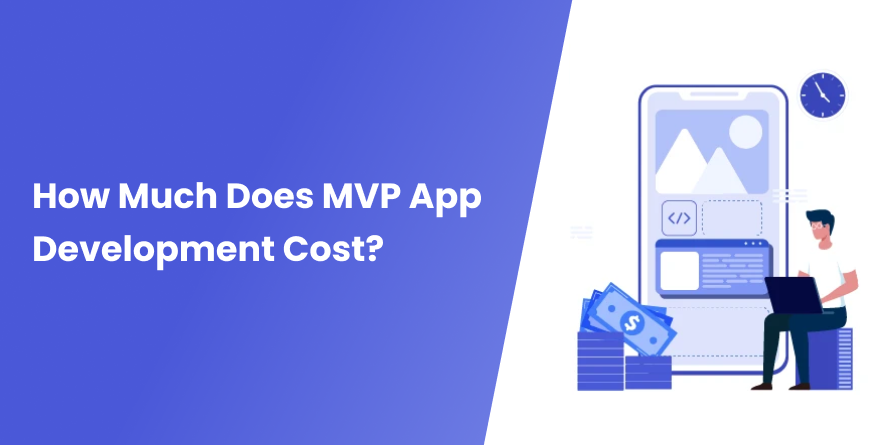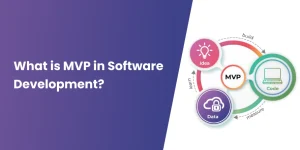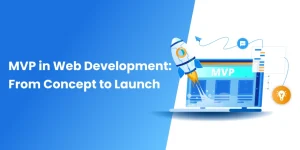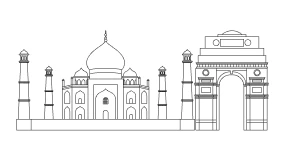MVP App Development Cost: Factors and Pricing Breakdown

Turning a brilliant idea into a successful digital product is the dream of every entrepreneur, but the journey from concept to execution is where many stumble. According to data from CB Insights, 35% of startups fail simply because there’s no market need for their product. Without proper validation, time and resources are often wasted on building features that users don’t want.
That’s where the MVP, Minimum Viable Product, approach has emerged as a game-changer, offering startups a smart way to test their core idea quickly, collect feedback, and interest fast without burning through their budget.
Today, more and more founders are leaning towards building MVPs first, but most don’t know where to start, what features to include, or how much it will realistically cost. Understanding the MVP app development cost is important for making informed decisions early on.
In this guide, we’ll break down the key factors that influence MVP costs, how to optimize development expenses, and provide actionable tips for getting your product to market efficiently.
Why Budget Planning Necessary in MVP Development?
Budget planning is a crucial step in MVP development, but many first-time founders skip it in the rush to launch.
Without a proper budget, you may:
- Overspend on features that aren’t essential
- Miss out on hidden costs
- Run out of funds before launch
Here’s how budget planning helps:
- Prevents overspending
- Sets clear milestones
- Identifies hidden costs
- Enables smarter funding decisions
- Improves team alignment
- Reduces the risk of failure
A well-planned budget isn’t just about saving money, it’s about using resources wisely, setting realistic expectations, and giving your MVP a higher chance of success. In a lean startup environment, knowing your MVP app costs can be the difference between gaining traction and falling short.
Also Read: MVP in Software Development
What is the Average Cost of MVP App Development?
The cost of building an MVP app typically ranges between $15,000 and $60,000, depending on complexity, features, and the development approach you choose.
Here’s a quick breakdown:
- Basic MVP (single platform, core features only): $15,000 – $30,000
- Mid-level MVP (cross-platform, custom UI/UX, moderate features): $30,000 – $45,000
- Complex MVP (advanced features like AI/ML, scalable backend, third-party integrations): $45,000 – $60,000+
For example, if you were building a ride-hailing MVP like Uber, you wouldn’t start with every feature. Instead, your MVP could focus on essentials such as:
- User registration & login
- Location tracking
- Ride booking & fare estimation
- Driver assignment
- Basic payment method
Even with just these features, the final cost would vary based on your chosen development team, tools, and design requirements.
In short, the average MVP cost isn’t fixed; it depends on your goals, features, and how you build it. A well-scoped MVP not only saves money but also helps validate your idea, attract early users, and prepare for future scaling.
Factors that Influencing the MVP Development Cost
When estimating the cost of building a Minimum Viable Product (MVP), it’s important to go beyond just development hours. Several core elements contribute to the total budget, ranging from team structure to technology stack, and even the region where your team operates.
Knowing what drives costs helps you plan smarter and avoid unpleasant surprises later.
Scope and Complexity of Features
Simple MVP Application
- Features: User login, profile setup, dashboard, and one core function
- Cost: Lower, since development is quick and straightforward
Intermediate MVP Application
- Features: Push notifications, in-app chat, payment gateway, third-party integrations
- Cost: Moderate, as these features require extra coding and testing
Complex MVP Application
- Features: Real-time GPS tracking, video streaming, AI/ML features, advanced analytics, multi-platform support
- Cost: Higher, as these demand more development time, advanced tech stack, and specialized expertise
Design and User Experience (UX/UI)
The quality of design and user experience plays a big role in MVP cost. A basic design saves money, but if you want your product to stand out and reflect your brand, investing in custom UI/UX is worth it.
- Basic Design (Template-Based) – Use ready-made templates, minimal customization, simple layouts.
- Moderate Design – Use branded color schemes, improved navigation, responsive design, better usability.
- Advanced Design – Fully custom UI, interactive animations, personalized user journeys, seamless UX across devices.
A polished design can be the difference between users staying engaged or abandoning your MVP after the first use.
Technology Stack
The technology stack you choose for your MVP plays a huge role in both cost and development speed. Here are the common options:
- Cross-Platform (Cost-Effective): One codebase for iOS & Android (Flutter, React Native). Faster and cheaper to build.
- Native Development (High Performance): Separate apps for iOS and Android. Higher cost but best performance and scalability.
- Web-Based MVP (Fast & Flexible): Built with React.js, Angular, or Vue.js. Lower investment, good for quick idea validation. If you’re exploring this route, check out our guide on MVP web.
Team Type and Location
Who you hire dedicated developers and where they’re based has a major impact on your MVP cost.
- Freelancers: Affordable but may lack reliability and long-term commitment. Good for very small projects or quick prototypes.
- Agencies: More expensive, but provide full teams (designers, developers, QA, PMs) with proven processes and support.
- Dedicated Developers / In-house Teams: Offer maximum control and alignment, but come with higher salaries and overhead costs.
Location also matters:
- U.S. & Western Europe: High rates ($80–$150/hr) but strong expertise.
- Eastern Europe & Asia: More cost-effective ($25–$60/hr) while still delivering quality work.
The right choice depends on your budget, timeline, and how much control you want over the development process.
Time to Market
How quickly you want to launch your MVP also affects the cost.
- Fast Launch (Higher Cost): If you need to hit the market quickly, you’ll likely need a bigger team, overtime work, or parallel developmentm, all of which increase expenses.
- Gradual Launch (Cost-Effective): Taking more time allows you to build in phases, spread out costs, and refine features based on feedback.
Post Launch Support and Maintenance
The work doesn’t stop after launching your MVP. Regular updates, bug fixes, and performance improvements are necessary to keep your app stable and user-friendly.
- Bug Fixes & Updates: Early users will give feedback, and you’ll need to quickly resolve issues or add missing features.
- Scalability Needs: As your user base grows, you may need to upgrade servers, enhance security, or optimize performance.
- Long-Term Stability: Continuous support ensures your MVP doesn’t lose users due to crashes, outdated design, or poor experience.
So, ongoing maintenance is essential to retain users and keep the product stable.
Tips to Reduce MVP App Development Cost
Building a Minimum Viable Product doesn’t have to drain your startup budget. With the right strategies, you can reduce costs without compromising on product quality or user experience.
Prioritize Core Features Only
Focus on solving the main user problem with just the essential features. Avoid the temptation to add “nice-to-have” functionalities in the first version.
Use Ready-made Components
Leverage open-source libraries, UI kits, and third-party APIs. This significantly speeds up development and cuts down on design and coding time.
Choose Cross-platform Development
Frameworks like Flutter or React Native let you build apps for both iOS and Android from a single codebase – saving time and money.
Start With Wireframes or Prototypes
Before jumping into code, create low-fidelity wireframes or interactive prototypes. It reduces miscommunication and rework during development.
Avoid Building Custom Admin Panels Early On
Use pre-built admin tools like Firebase or Retool initially, and consider custom admin interfaces later when you scale.
Hire a Team from Cost-Efficient Regions
Skilled developers from regions like Eastern Europe, India, or Latin America often deliver high-quality work at lower hourly rates.
Typical Timeline for MVP Development
Building an MVP is all about speed and focus, but even a “minimum” version requires careful planning and execution. On average, it takes 8 to 16 weeks to develop a functional MVP, depending on complexity and team structure.
Week 1-2: Discovery & Planning
This phase includes defining your product vision, target users, features list, and technical requirements. Wireframes or Prototypes may also be created during this stage.
Week 3-4: UI/UX Design
Designers craft the visual layout and user experience, creating clickable prototypes and mockups. The goal is to ensure intuitive navigation and branding consistency.
Weeks 5-10: Development
Developers begin coding the front end and back end. If you’re using cross-platform tools or hiring a dedicated development team, this phase can be streamlined for faster delivery.
Week 11-12: Testing & QA
Before launch, the MPV undergoes rigorous testing to fix bugs, ensure performance, and validate user flows across different devices and platforms.
Week 13-14: Launch & Feedback Collection
This MVP is deployed to a limited audience. This is your opportunity to gather real-world feedback and measure user agreement to guide future iterations.
Conclusion
In conclusion, MVP app development can be a highly beneficial investment for businesses. In this blog post, we discussed the various factors that affect the MVP app development cost, the cost breakdown, and the timeline for MVP development.
As an experienced MVP development company, We at Guru TechnoLabs can help you arrive at a ballpark estimate for product development and delivery. We are experts in delivering high-quality and scalable MVPs that drive substantial growth for your startup.
Contact us to discover your product idea with our experts to get started on your journey.
Frequently Asked Questions
The cost to build an MVP app in 2025 typically ranges from $10,000 -$60,000, depending on complexity, development method (freelancer, in-house, agency), and region of your development team.
Focus only on core functionalities that solve the main user problem. Avoid extra features and prioritize a lean, testable version that validates your idea with real users.
Freelancers can be cheaper upfront ($5,000–$15,000), but outsourcing to a reliable team offers better project management, accountability, and support, often making it more cost-effective long term.
MVP development typically takes 8 to 16 weeks. The longer the timeline or the more features added, the higher the cost, especially if you’re paying by the hour or sprint.
Yes. Using cross-platform frameworks, open-source tools, and hiring developers from cost-efficient regions are proven ways to lower expenses while maintaining quality.


















